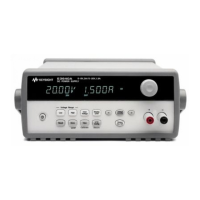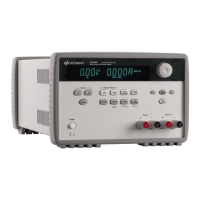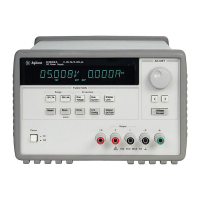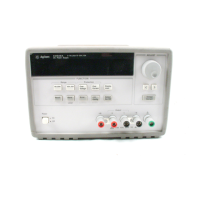Chapter 4 Remote Interface Reference
Output Setting and Operation Commands
90
VOLTage:PROTection {<voltage>|MINimum|MAXimum}
Set the voltage level at which the overvoltage protection (OVP) circuit will trip. If
the peak output voltage exceeds the OVP level, then the power supply output is shorted
by an internal SCR. An overvoltage condition can be cleared with the
VOLT:PROT:CLE command after the condition that caused the OVP trip is removed.
VOLTage:PROTection? [MINimum | MAXimum]
Query the overvoltage protection trip level presently programmed.
VOLTage:PROTection:STATe {0 | 1 | OFF | ON}
Enable or disable the overvoltage protection function. At *RST, this value is set to
‘‘ON’’.
VOLTage:PROTection:STATe?
Query the state of the overvoltage protection function. The returned parameter is ‘‘0’’
(OFF) or ‘‘1’’ (ON).
VOLTage:PROTection:TRIPped?
Return a ‘‘1’’ if the overvoltage protection circuit is tripped and not cleared or a ‘‘0’’
if not tripped.
VOLTage:PROTection:CLEar
Cause the overvoltage protection circuit to be cleared. After this command, the output
voltage is restored to the state it was in before the protection feature occurred and the
OVP trip level remains unchanged to the value presently programmed. Before sending
this command, lower the output voltage below the trip OVP point, or raise the OVP
trip level above the output setting. Note that the overvoltage condition caused by an
external source must be removed first before proceeding this command.
VOLTage:RANGe {P8V* | P20V* | P35V** | P60V** | LOW | HIGH}
Select an output range to be programmed by the identifier. For example, ‘‘P20V’’ or
‘‘HIGH’’ is the identifier for the 20V/1.5A range and ‘‘P8V’’ or ‘‘LOW’’ is for the
8V/3A range (for E3646A model). At *RST, low voltage range is selected.
VOLTage:RANGe?
Query the currently selected range. The returned parameter is ‘‘P8V’’ or ‘‘P35V’’ for
low voltage range, or ‘‘P20V’’ or ‘‘P60V’’ for high voltage range.

